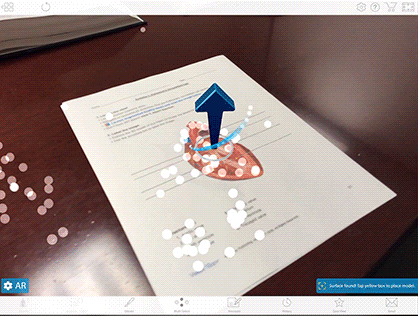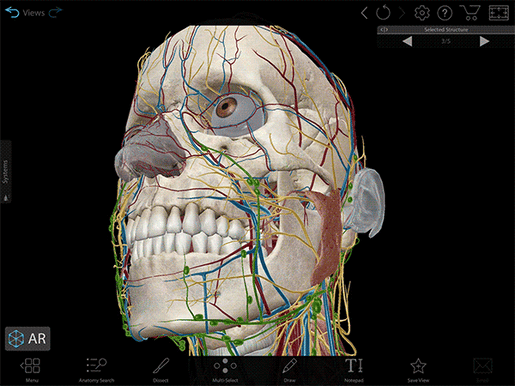Reach More Students: Differentiated Instruction with Visible Body
Posted on 7/8/22 by Sarah Boudreau
Differentiated instruction is the concept that every student is different, so a one-size-fits-all approach to instruction won’t fit.
In a traditional classroom, students receive information by listening to a lecture or reading a textbook, they study for the test by rereading their notes, and then they take an exam to assess their knowledge of the material. Under a differentiated instruction approach, teachers give their students different options for learning, often incorporating multiple modalities.
As differentiated instruction pioneer Dr. Carol Ann Tomlinson wrote in her book The Differentiated Classroom: Responding to the Needs of All Learners, “In a differentiated classroom, the teacher unconditionally accepts students as they are, and she expects them to become all they can be.”
“There are many ways in which the app is beneficial to us teachers. DI, or differentiated instruction, is something that is harped on by most counties and is easily attainable and used during each instructional period,” said Richard Mantrana, lead instructor of the medical academy at Southwest Miami Senior High School, during a webinar. His students benefit greatly from the 3D models included in Courseware, Visible Body’s teaching and learning platform, and he highlighted how the interactive features have helped English language learners, students with 504 plans, and more.
Today on the Visible Body Blog, we’re going to briefly explore this rich topic and give you some tools for your classroom. Dr. Tomlinson describes three areas that are differentiated in the classroom: content, process, and product. We’ll talk about each of these areas and how Visible Body can support a differentiated classroom.
Content
Content simply refers to the material taught in a class or how the student acquires the information.
Since courses like anatomy and physiology require rote memorization so students can apply their knowledge to subsequent classes or board exams, it’s not practical to have students choose their own material (unlike, for example, an English classroom where students choose which book they want to read). The best way to differentiate content is through how the information is presented to the students.
Experts recommend using a variety of instructional materials when presenting information. This concept is at the heart of Visible Body!
Through Courseware, students and teachers have access to over 6,000 3D structures. Each of these structures can be selected, tagged, annotated, and hidden or dissected. Clicking on the structure brings up a definition, pronunciation, a box of related content, and (if applicable) a list of associated pathologies.
.jpg?width=515&name=My%20project%20(13).jpg) Image from Visible Biology.
Image from Visible Biology.
There are major benefits to learning in interactive 3D as it encourages spatial cognitive processing and boosts engagement and interest. A 2021 study used 3D models in the instruction of about 800 cell biology students—95% of whom agreed or strongly agreed that the visuals helped them understand the concept at hand.
Another way instructors can go beyond the textbook is by introducing information through the apps’ bite-size animations that illustrate processes quickly and efficiently. In addition to the in-app animations, you can check out Visible Biology’s ongoing YouTube series, wherein videos about ten minutes in length unpack biological concepts, starting with the structure of DNA. Use videos as a lecture or review tool in class, or assign them as homework as part of a flipped classroom model!
You can also make use of the augmented reality feature in the Visible Body Suite app, available through Courseware. There’s a wealth of scholarship on how AR makes students more engaged and more invested in the subject matter. For example, in a review of AR in medical education literature, the authors observed that AR can increase creativity and innovation in addition to professional knowledge.
Moreover, apps like Visible Body Suite and Visible Biology are built for discovery and exploration, as students can select structures, zoom in and out, move between views in the related content box, and add their own notes and annotations. Visible Body encourages students to be active learners who investigate new ideas.
Process
Process describes how the student processes what they’ve learned, typically through labs and other activities that reinforce and apply information.
Here are some activity ideas that can appeal to different students:
- Create an interactive graphic novel: Students can create their own “graphic novel” textbook chapter using the Tours feature to combine saved views into “pages.” Students can select a model; position it; use the draw tool to annotate it with arrows, shapes, and freehand drawings; and add text in their own words using the note feature. Students can easily share their Tours with a few clicks. Students are encouraged to use high-order thinking when considering how to organize the information and put views into a sequence.
- Complete labs in augmented reality: For anatomy and physiology classrooms, Visible Body offers several AR lab activities to bring a level of interactivity to worksheets.
- Head back to kindergarten: In this activity, students prepare their own short lectures using Tours as if they were explaining the concepts to a kindergarten class. In small groups, have each student share their lectures while the other group members ask them questions a kindergartener might have, like “What’s that blue thing?” or “What does ‘cancellous bone’ mean?” The presenting student answers their questions using the Tour as a visual aid.
- Build your own Flashcard Deck: Students can make their own Flashcard Deck based around a particular theme, writing out a prompt on the front of the card and identifying the structure on the back. To challenge students, limit the number of words they can use in their prompts.
For more activities that will shake up your classroom, check out this blog post: 5 Ways to Gamify Your A&P Classroom with Visible Body!
 AR lab activity using the VB Suite mobile app.
AR lab activity using the VB Suite mobile app.
Product
Last but not least, product refers to how the student shows what they’ve learned. In a traditional classroom, this is the dreaded exam—but assessment doesn’t have to be strictly multiple-choice and short answer tests.
Below are some different options students could use to show their knowledge. The first two come from Dr. Cindy Harley’s excellent webinar on alternative assessments, where she goes into detail on how and why she’s changed assessment in her classroom.
- Sketch notes: In sketch notes, students use visual elements and minimal text to illustrate what they’ve learned, literally drawing connections between concepts. Rather than simply memorizing content, sketch notes ask students to choose an organizational structure and link ideas together, encouraging critical thought.
- Walk-through videos: In an asynchronous class, students use screen capture apps to record themselves walking the viewer through a particular system or body part, using the dissection and drawing functions to illustrate their points. When students begin their careers, odds are they will have to explain concepts to others, and this form of assessment helps them develop explanatory skills.
- A&P through pathology: Students create a presentation on a pathology of their choice using Visible Body models, explaining how that pathology affects the anatomy and physiology. Focusing on clinical knowledge contextualizes A&P content, helping students remember information.
- Design your own test: Students whose classrooms use Courseware would probably be familiar with dissection quizzes. As a final assessment, have students write their own quiz prompts. Students will record their screens as they access the appropriate models, read the questions aloud, and use the dissection tool to find and select the correct answer.
- Poster sessions: Similar to poster sessions at a conference, students will create a poster based around a given or chosen topic. Using an app like Visible Biology or VB Suite, students will create their own images for their posters through manipulating and annotating models. Creating the images themselves rather than finding them on Google Images means they’re thinking critically and creatively about the content. The teacher and other students can walk around the room, asking clarifying questions of the poster presenters.
 Example of a Tour in VB Suite.
Example of a Tour in VB Suite.
Assessment, instruction, and support
We’ve thrown around a lot of ideas, but ultimately, the instructor knows their students best. Reflection and assessment are crucial elements of differentiated instruction.
The traditional approach is to assess student knowledge at the end of the learning process, perhaps during unit exams, but Dr. Tomlinson writes about teachers as “architects” of learning and assessment as diagnostic in nature. In order to build lessons, teachers must determine what is working, what is not working, and what challenges students might face as the course progresses.
A teacher can assess through formal assessments, like quizzes and tests, or through questionnaires and other feedback requests, but teachers can always conduct informal assessments by observing students as they take in information, process it, and show what they have learned.
Teachers know their students best, so Visible Body works hard to support them and the whole classroom. In addition to free classroom content like premade Tours, Flashcard Decks, and lab manuals, we offer free webinars and an “office hours” series to connect users with the tools and community they need to succeed. Our Customer Engagement Team is excited to help instructors utilize all the features that will keep their students engaged, offering customized, one-on-one training.
With a differentiated classroom, more students can connect with the content, and Visible Biology offers tools and resources to facilitate growth and learning.
Be sure to subscribe to the Visible Body Blog for more awesomeness!
Are you an instructor? We have award-winning 3D products and resources for your anatomy and physiology course! Learn more here.



